2005 NISSAN NAVARA engine
[x] Cancel search: enginePage 1133 of 3171
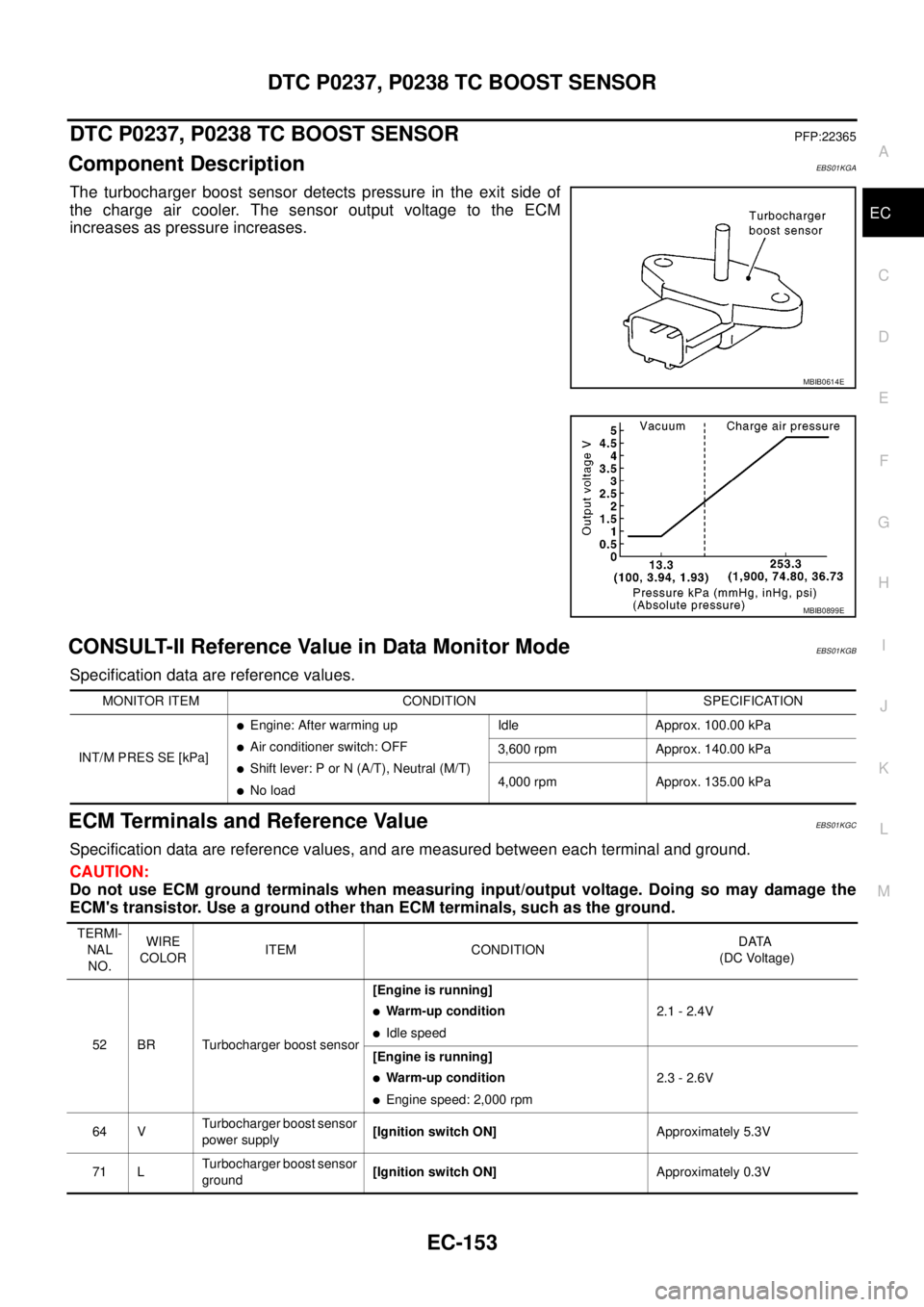
DTC P0237, P0238 TC BOOST SENSOR
EC-153
C
D
E
F
G
H
I
J
K
L
MA
EC
DTC P0237, P0238 TC BOOST SENSORPFP:22365
Component DescriptionEBS01KGA
The turbocharger boost sensor detects pressure in the exit side of
the charge air cooler. The sensor output voltage to the ECM
increases as pressure increases.
CONSULT-II Reference Value in Data Monitor ModeEBS01KGB
Specification data are reference values.
ECM Terminals and Reference ValueEBS01KGC
Specification data are reference values, and are measured between each terminal and ground.
CAUTION:
Do not use ECM ground terminals when measuring input/output voltage. Doing so may damage the
ECM's transistor. Use a ground other than ECM terminals, such as the ground.
MBIB0614E
MBIB0899E
MONITOR ITEM CONDITION SPECIFICATION
INT/M PRES SE [kPa]
lEngine: After warming up
lAir conditioner switch: OFF
lShift lever: P or N (A/T), Neutral (M/T)
lNo loadIdle Approx. 100.00 kPa
3,600 rpm Approx. 140.00 kPa
4,000 rpm Approx. 135.00 kPa
TERMI-
NAL
NO.WIRE
COLORITEM CONDITIONDATA
(DC Voltage)
52 BR Turbocharger boost sensor[Engine is running]
lWarm-up condition
lIdle speed2.1 - 2.4V
[Engine is running]
lWarm-up condition
lEngine speed: 2,000 rpm2.3 - 2.6V
64 VTurbocharger boost sensor
power supply[Ignition switch ON]Approximately 5.3V
71 LTurbocharger boost sensor
ground[Ignition switch ON]Approximately 0.3V
Page 1139 of 3171
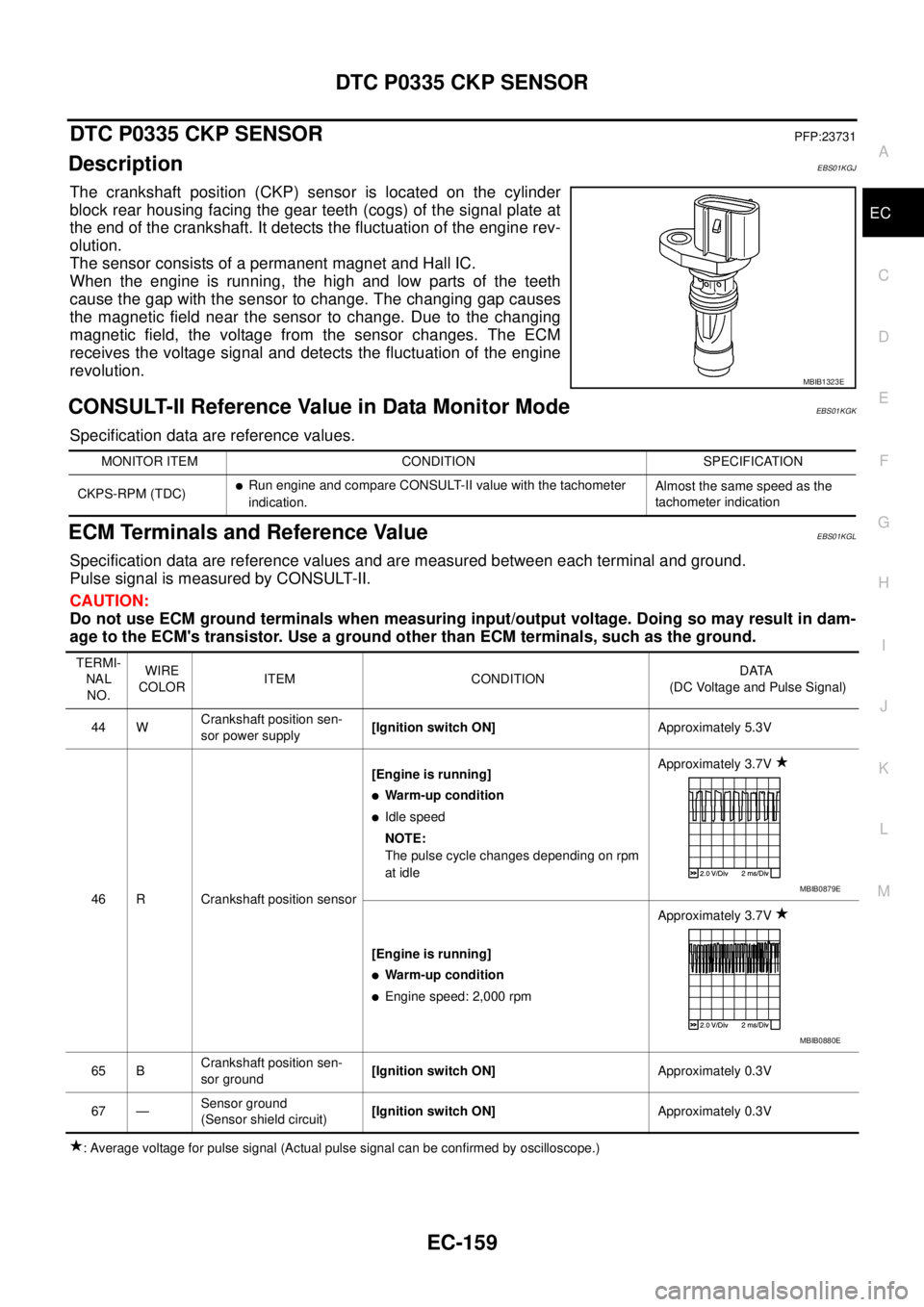
DTC P0335 CKP SENSOR
EC-159
C
D
E
F
G
H
I
J
K
L
MA
EC
DTC P0335 CKP SENSORPFP:23731
DescriptionEBS01KGJ
The crankshaft position (CKP) sensor is located on the cylinder
block rear housing facing the gear teeth (cogs) of the signal plate at
the end of the crankshaft. It detects the fluctuation of the engine rev-
olution.
The sensor consists of a permanent magnet and Hall IC.
When the engine is running, the high and low parts of the teeth
cause the gap with the sensor to change. The changing gap causes
the magnetic field near the sensor to change. Due to the changing
magnetic field, the voltage from the sensor changes. The ECM
receives the voltage signal and detects the fluctuation of the engine
revolution.
CONSULT-II Reference Value in Data Monitor ModeEBS01KGK
Specification data are reference values.
ECM Terminals and Reference ValueEBS01KGL
Specification data are reference values and are measured between each terminal and ground.
Pulse signal is measured by CONSULT-II.
CAUTION:
Do not use ECM ground terminals when measuring input/output voltage. Doing so may result in dam-
age to the ECM's transistor. Use a ground other than ECM terminals, such as the ground.
: Average voltage for pulse signal (Actual pulse signal can be confirmed by oscilloscope.)
MBIB1323E
MONITOR ITEM CONDITION SPECIFICATION
CKPS-RPM (TDC)
lRun engine and compare CONSULT-II value with the tachometer
indication.Almost the same speed as the
tachometer indication
TERMI-
NAL
NO.WIRE
COLORITEM CONDITIONDATA
(DC Voltage and Pulse Signal)
44 WCrankshaft position sen-
sor power supply[Ignition switch ON]Approximately 5.3V
46 R Crankshaft position sensor[Engine is running]
lWarm-up condition
lIdle speed
NOTE:
The pulse cycle changes depending on rpm
at idleApproximately 3.7V
[Engine is running]
lWarm-up condition
lEngine speed: 2,000 rpmApproximately 3.7V
65 BCrankshaft position sen-
sor ground[Ignition switch ON]Approximately 0.3V
67 —Sensor ground
(Sensor shield circuit)[Ignition switch ON]Approximately 0.3V
MBIB0879E
MBIB0880E
Page 1140 of 3171
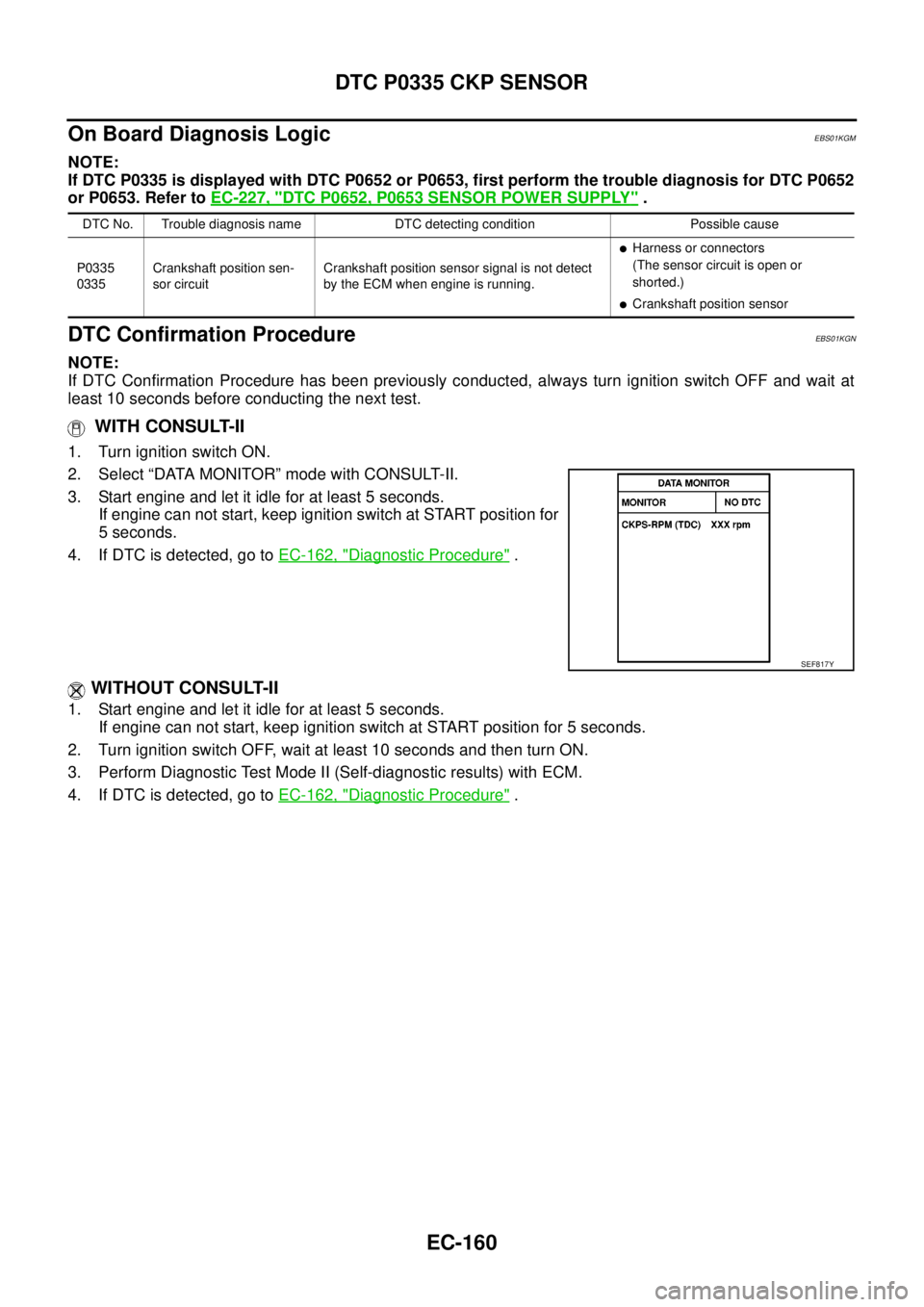
EC-160
DTC P0335 CKP SENSOR
On Board Diagnosis Logic
EBS01KGM
NOTE:
If DTC P0335 is displayed with DTC P0652 or P0653, first perform the trouble diagnosis for DTC P0652
or P0653. Refer toEC-227, "
DTC P0652, P0653 SENSOR POWER SUPPLY".
DTC Confirmation ProcedureEBS01KGN
NOTE:
If DTC Confirmation Procedure has been previously conducted, always turn ignition switch OFF and wait at
least 10 seconds before conducting the next test.
WITH CONSULT-II
1. Turn ignition switch ON.
2. Select “DATA MONITOR” mode with CONSULT-II.
3. Start engine and let it idle for at least 5 seconds.
If engine can not start, keep ignition switch at START position for
5 seconds.
4. If DTC is detected, go toEC-162, "
Diagnostic Procedure".
WITHOUT CONSULT-II
1. Start engine and let it idle for at least 5 seconds.
If engine can not start, keep ignition switch at START position for 5 seconds.
2. Turn ignition switch OFF, wait at least 10 seconds and then turn ON.
3. Perform Diagnostic Test Mode II (Self-diagnostic results) with ECM.
4. If DTC is detected, go toEC-162, "
Diagnostic Procedure".
DTC No. Trouble diagnosis name DTC detecting condition Possible cause
P0335
0335Crankshaft position sen-
sor circuitCrankshaft position sensor signal is not detect
by the ECM when engine is running.
lHarness or connectors
(The sensor circuit is open or
shorted.)
lCrankshaft position sensor
SEF817Y
Page 1145 of 3171
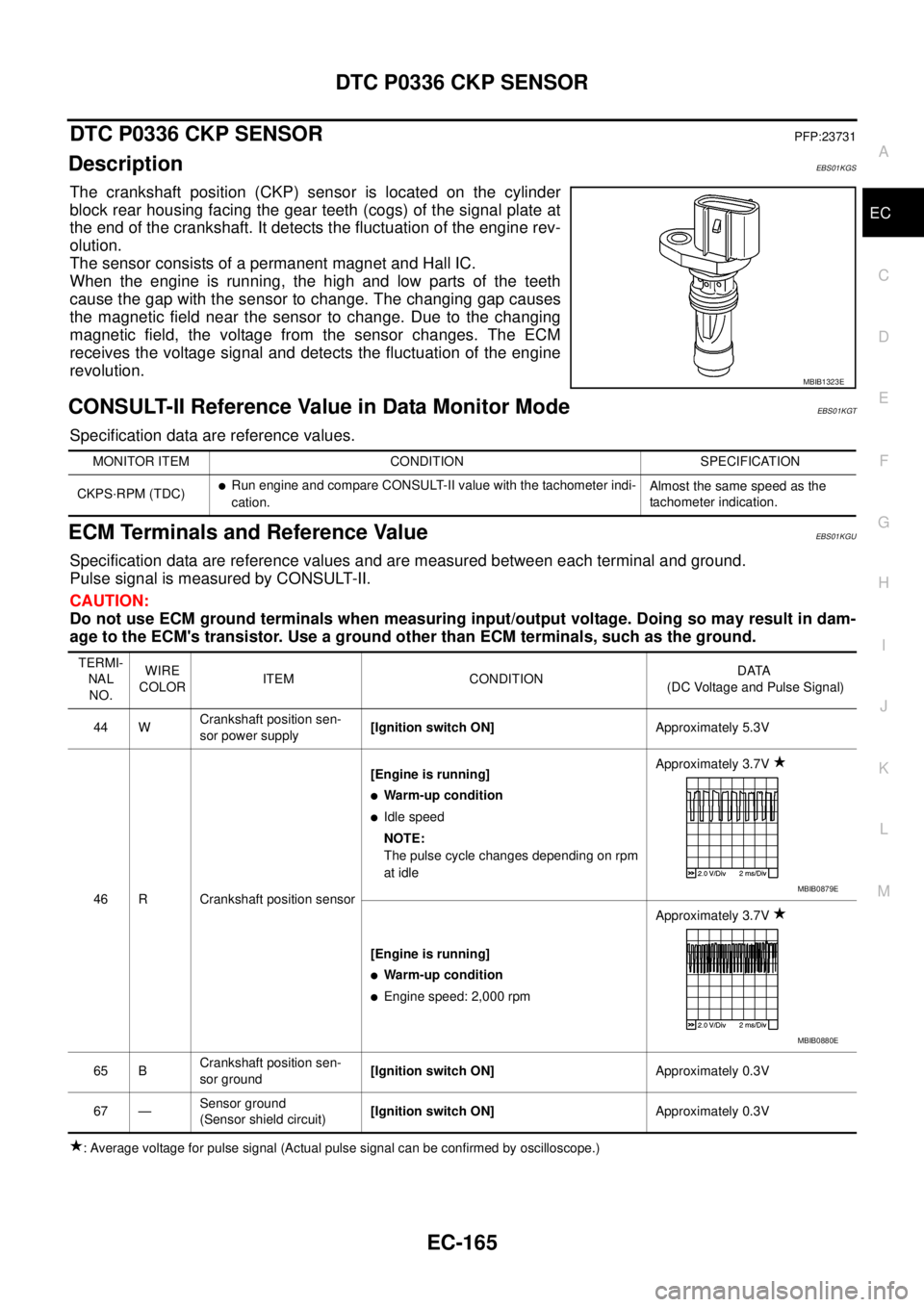
DTC P0336 CKP SENSOR
EC-165
C
D
E
F
G
H
I
J
K
L
MA
EC
DTC P0336 CKP SENSORPFP:23731
DescriptionEBS01KGS
The crankshaft position (CKP) sensor is located on the cylinder
block rear housing facing the gear teeth (cogs) of the signal plate at
the end of the crankshaft. It detects the fluctuation of the engine rev-
olution.
The sensor consists of a permanent magnet and Hall IC.
When the engine is running, the high and low parts of the teeth
cause the gap with the sensor to change. The changing gap causes
the magnetic field near the sensor to change. Due to the changing
magnetic field, the voltage from the sensor changes. The ECM
receives the voltage signal and detects the fluctuation of the engine
revolution.
CONSULT-II Reference Value in Data Monitor ModeEBS01KGT
Specification data are reference values.
ECM Terminals and Reference ValueEBS01KGU
Specification data are reference values and are measured between each terminal and ground.
Pulse signal is measured by CONSULT-II.
CAUTION:
Do not use ECM ground terminals when measuring input/output voltage. Doing so may result in dam-
age to the ECM's transistor. Use a ground other than ECM terminals, such as the ground.
: Average voltage for pulse signal (Actual pulse signal can be confirmed by oscilloscope.)
MBIB1323E
MONITOR ITEM CONDITION SPECIFICATION
CKPS·RPM (TDC)
lRun engine and compare CONSULT-II value with the tachometer indi-
cation.Almost the same speed as the
tachometer indication.
TERMI-
NAL
NO.WIRE
COLORITEM CONDITIONDATA
(DC Voltage and Pulse Signal)
44 WCrankshaft position sen-
sor power supply[Ignition switch ON]Approximately 5.3V
46 R Crankshaft position sensor[Engine is running]
lWarm-up condition
lIdle speed
NOTE:
The pulse cycle changes depending on rpm
at idleApproximately 3.7V
[Engine is running]
lWarm-up condition
lEngine speed: 2,000 rpmApproximately 3.7V
65 BCrankshaft position sen-
sor ground[Ignition switch ON]Approximately 0.3V
67 —Sensor ground
(Sensor shield circuit)[Ignition switch ON]Approximately 0.3V
MBIB0879E
MBIB0880E
Page 1146 of 3171
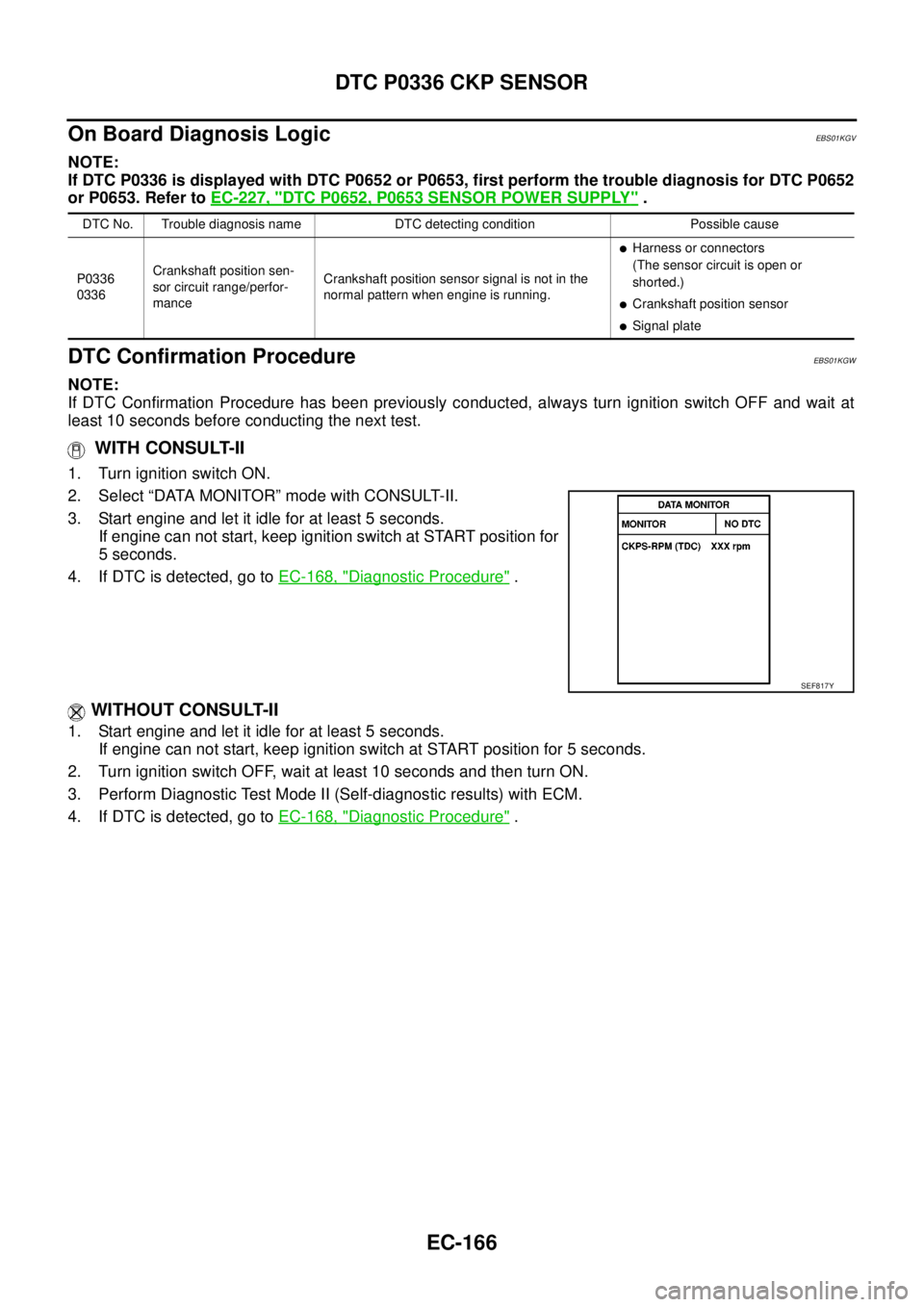
EC-166
DTC P0336 CKP SENSOR
On Board Diagnosis Logic
EBS01KGV
NOTE:
If DTC P0336 is displayed with DTC P0652 or P0653, first perform the trouble diagnosis for DTC P0652
or P0653. Refer toEC-227, "
DTC P0652, P0653 SENSOR POWER SUPPLY".
DTC Confirmation ProcedureEBS01KGW
NOTE:
If DTC Confirmation Procedure has been previously conducted, always turn ignition switch OFF and wait at
least 10 seconds before conducting the next test.
WITH CONSULT-II
1. Turn ignition switch ON.
2. Select “DATA MONITOR” mode with CONSULT-II.
3. Start engine and let it idle for at least 5 seconds.
If engine can not start, keep ignition switch at START position for
5 seconds.
4. If DTC is detected, go toEC-168, "
Diagnostic Procedure".
WITHOUT CONSULT-II
1. Start engine and let it idle for at least 5 seconds.
If engine can not start, keep ignition switch at START position for 5 seconds.
2. Turn ignition switch OFF, wait at least 10 seconds and then turn ON.
3. Perform Diagnostic Test Mode II (Self-diagnostic results) with ECM.
4. If DTC is detected, go toEC-168, "
Diagnostic Procedure".
DTC No. Trouble diagnosis name DTC detecting condition Possible cause
P0336
0336Crankshaft position sen-
sor circuit range/perfor-
manceCrankshaft position sensor signal is not in the
normal pattern when engine is running.
lHarness or connectors
(The sensor circuit is open or
shorted.)
lCrankshaft position sensor
lSignal plate
SEF817Y
Page 1151 of 3171
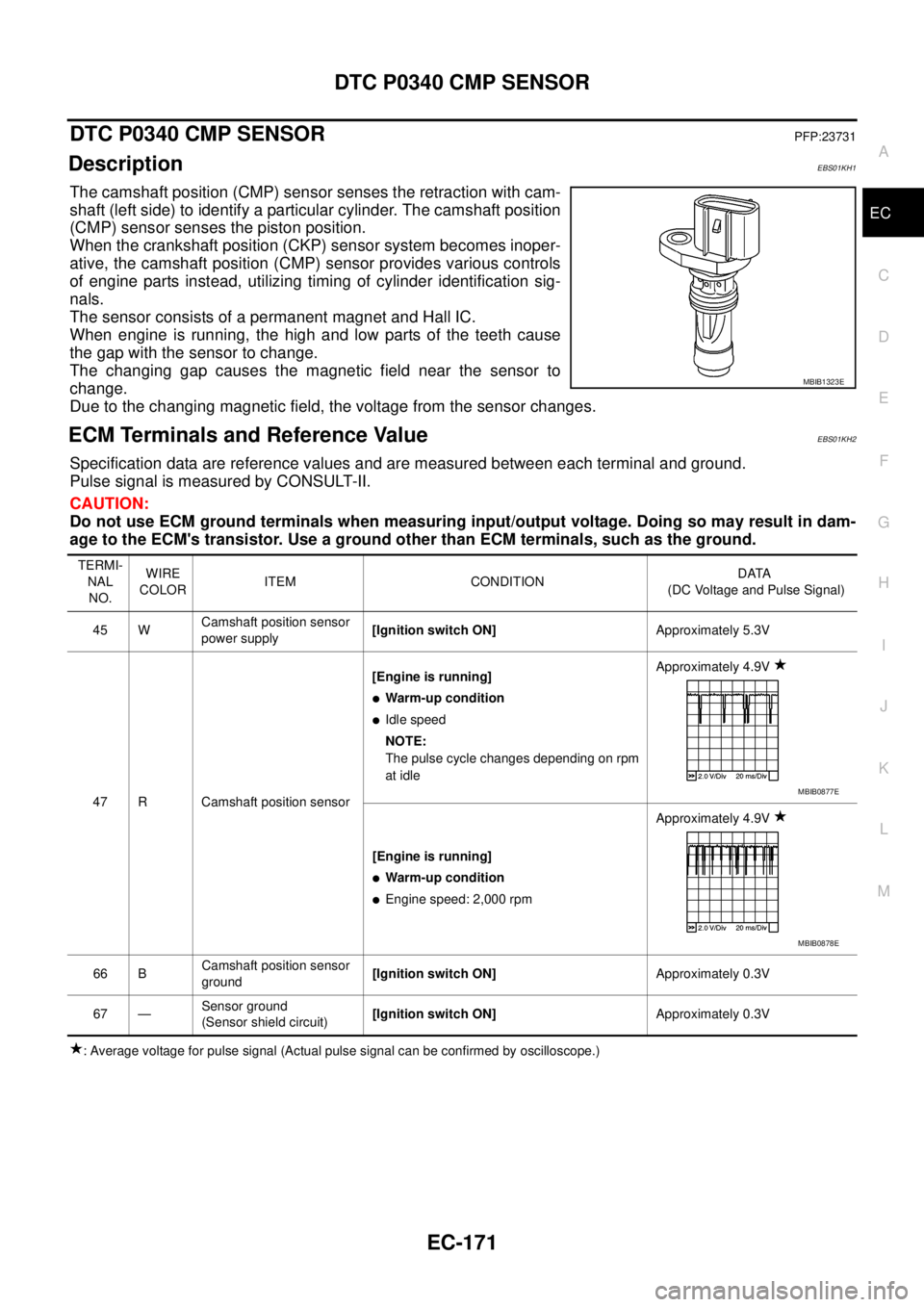
DTC P0340 CMP SENSOR
EC-171
C
D
E
F
G
H
I
J
K
L
MA
EC
DTC P0340 CMP SENSORPFP:23731
DescriptionEBS01KH1
The camshaft position (CMP) sensor senses the retraction with cam-
shaft (left side) to identify a particular cylinder. The camshaft position
(CMP) sensor senses the piston position.
When the crankshaft position (CKP) sensor system becomes inoper-
ative, the camshaft position (CMP) sensor provides various controls
of engine parts instead, utilizing timing of cylinder identification sig-
nals.
The sensor consists of a permanent magnet and Hall IC.
When engine is running, the high and low parts of the teeth cause
the gap with the sensor to change.
The changing gap causes the magnetic field near the sensor to
change.
Due to the changing magnetic field, the voltage from the sensor changes.
ECM Terminals and Reference ValueEBS01KH2
Specification data are reference values and are measured between each terminal and ground.
Pulse signal is measured by CONSULT-II.
CAUTION:
Do not use ECM ground terminals when measuring input/output voltage. Doing so may result in dam-
age to the ECM's transistor. Use a ground other than ECM terminals, such as the ground.
: Average voltage for pulse signal (Actual pulse signal can be confirmed by oscilloscope.)
MBIB1323E
TERMI-
NAL
NO.WIRE
COLORITEM CONDITIONDATA
(DC Voltage and Pulse Signal)
45 WCamshaft position sensor
power supply[Ignition switch ON]Approximately 5.3V
47 R Camshaft position sensor[Engine is running]
lWarm-up condition
lIdle speed
NOTE:
The pulse cycle changes depending on rpm
at idleApproximately 4.9V
[Engine is running]
lWarm-up condition
lEngine speed: 2,000 rpmApproximately 4.9V
66 BCamshaft position sensor
ground[Ignition switch ON]Approximately 0.3V
67 —Sensor ground
(Sensor shield circuit)[Ignition switch ON]Approximately 0.3V
MBIB0877E
MBIB0878E
Page 1152 of 3171
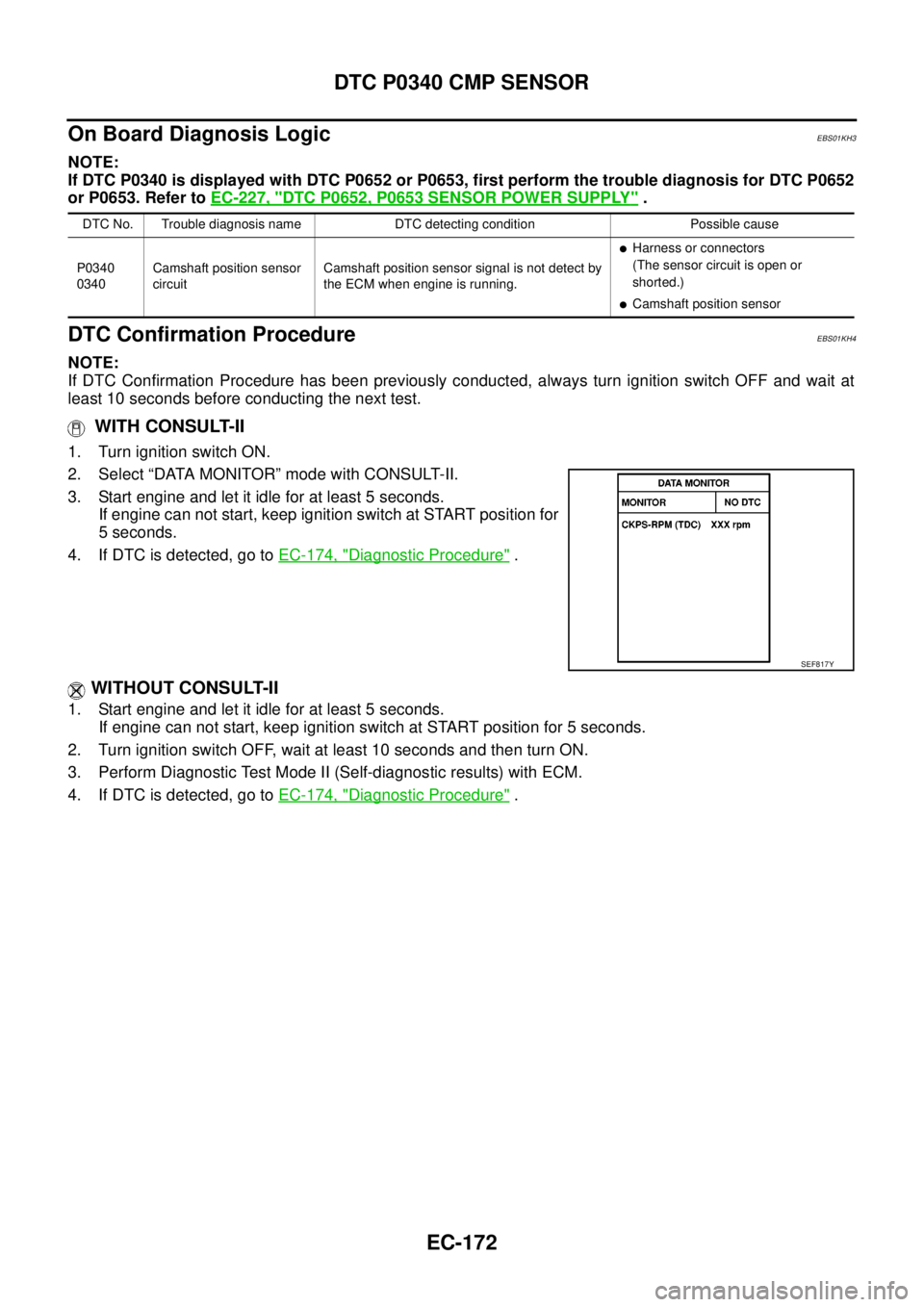
EC-172
DTC P0340 CMP SENSOR
On Board Diagnosis Logic
EBS01KH3
NOTE:
If DTC P0340 is displayed with DTC P0652 or P0653, first perform the trouble diagnosis for DTC P0652
or P0653. Refer toEC-227, "
DTC P0652, P0653 SENSOR POWER SUPPLY".
DTC Confirmation ProcedureEBS01KH4
NOTE:
If DTC Confirmation Procedure has been previously conducted, always turn ignition switch OFF and wait at
least 10 seconds before conducting the next test.
WITH CONSULT-II
1. Turn ignition switch ON.
2. Select “DATA MONITOR” mode with CONSULT-II.
3. Start engine and let it idle for at least 5 seconds.
If engine can not start, keep ignition switch at START position for
5 seconds.
4. If DTC is detected, go toEC-174, "
Diagnostic Procedure".
WITHOUT CONSULT-II
1. Start engine and let it idle for at least 5 seconds.
If engine can not start, keep ignition switch at START position for 5 seconds.
2. Turn ignition switch OFF, wait at least 10 seconds and then turn ON.
3. Perform Diagnostic Test Mode II (Self-diagnostic results) with ECM.
4. If DTC is detected, go toEC-174, "
Diagnostic Procedure".
DTC No. Trouble diagnosis name DTC detecting condition Possible cause
P0340
0340Camshaft position sensor
circuitCamshaft position sensor signal is not detect by
the ECM when engine is running.
lHarness or connectors
(The sensor circuit is open or
shorted.)
lCamshaft position sensor
SEF817Y
Page 1157 of 3171
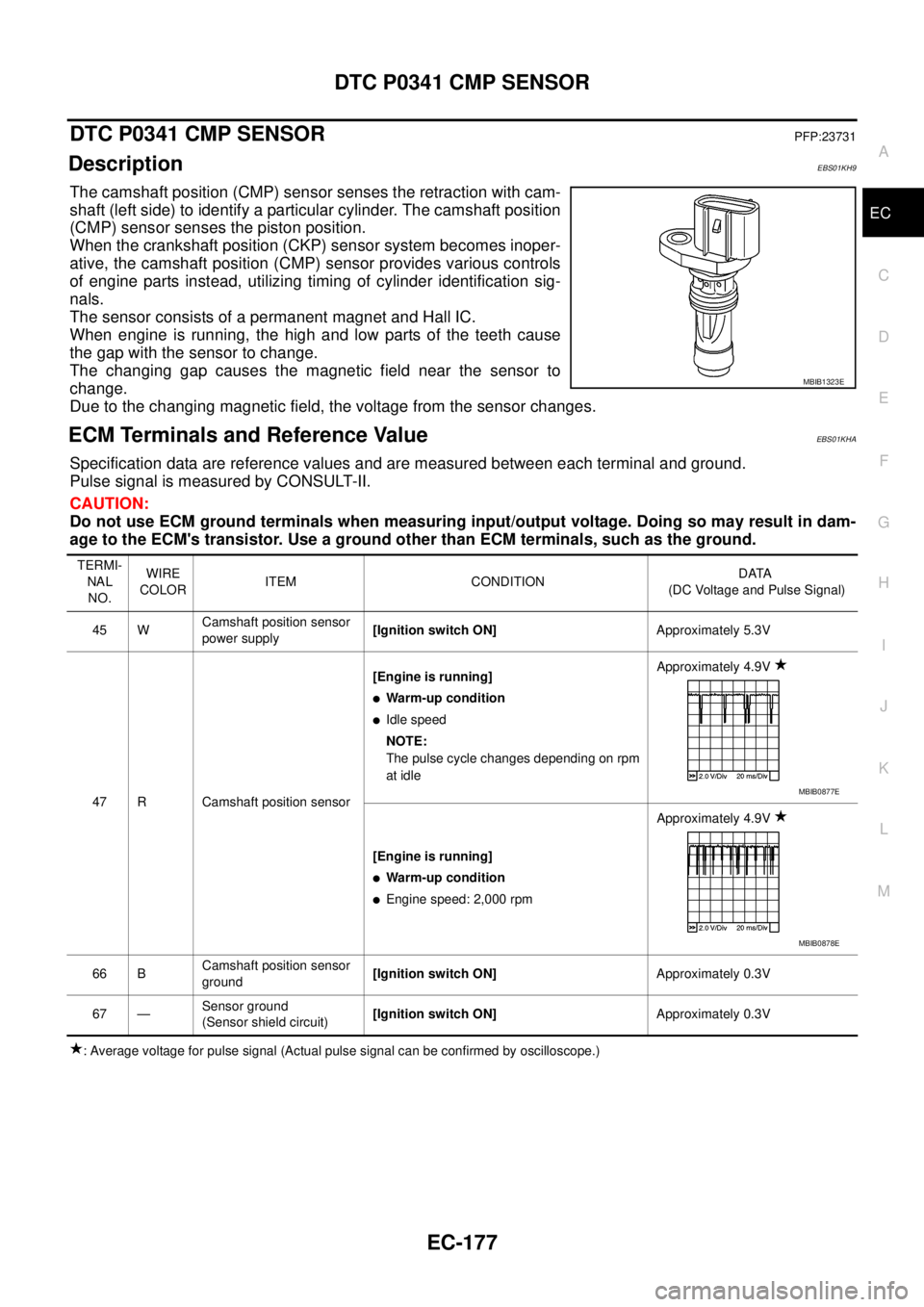
DTC P0341 CMP SENSOR
EC-177
C
D
E
F
G
H
I
J
K
L
MA
EC
DTC P0341 CMP SENSORPFP:23731
DescriptionEBS01KH9
The camshaft position (CMP) sensor senses the retraction with cam-
shaft (left side) to identify a particular cylinder. The camshaft position
(CMP) sensor senses the piston position.
When the crankshaft position (CKP) sensor system becomes inoper-
ative, the camshaft position (CMP) sensor provides various controls
of engine parts instead, utilizing timing of cylinder identification sig-
nals.
The sensor consists of a permanent magnet and Hall IC.
When engine is running, the high and low parts of the teeth cause
the gap with the sensor to change.
The changing gap causes the magnetic field near the sensor to
change.
Due to the changing magnetic field, the voltage from the sensor changes.
ECM Terminals and Reference ValueEBS01KHA
Specification data are reference values and are measured between each terminal and ground.
Pulse signal is measured by CONSULT-II.
CAUTION:
Do not use ECM ground terminals when measuring input/output voltage. Doing so may result in dam-
age to the ECM's transistor. Use a ground other than ECM terminals, such as the ground.
: Average voltage for pulse signal (Actual pulse signal can be confirmed by oscilloscope.)
MBIB1323E
TERMI-
NAL
NO.WIRE
COLORITEM CONDITIONDATA
(DC Voltage and Pulse Signal)
45 WCamshaft position sensor
power supply[Ignition switch ON]Approximately 5.3V
47 R Camshaft position sensor[Engine is running]
lWarm-up condition
lIdle speed
NOTE:
The pulse cycle changes depending on rpm
at idleApproximately 4.9V
[Engine is running]
lWarm-up condition
lEngine speed: 2,000 rpmApproximately 4.9V
66 BCamshaft position sensor
ground[Ignition switch ON]Approximately 0.3V
67 —Sensor ground
(Sensor shield circuit)[Ignition switch ON]Approximately 0.3V
MBIB0877E
MBIB0878E